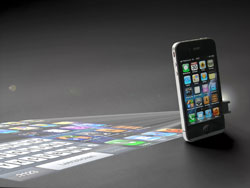Fraunhofer Institute Develops New Pico Projector Technology
 A new projection technology developed by Fraunhofer Institute for Applied Optics and Precision Engineering IOF has the potential to revolutionize the future of pico projection technology.
A new projection technology developed by Fraunhofer Institute for Applied Optics and Precision Engineering IOF has the potential to revolutionize the future of pico projection technology.
This technology combines two concepts — strength in numbers and bug eyes. Literally.
This LED-based projection technology uses “wafers” containing about 300 chips, each housing 200 lenses for the microprojectors enabling the device to project a clear, crisp image from any angle — so no more keystoning. So far the projections are DIN A4 in size (European standard paper size).
Right now the technology is being applied to smartphones on the basis that their small display sizes limit a user’s ability to operate the phone or even share graphical information with groups (no more playing the game of “pass the iPhone” to see cat pictures before the appetizers arrive).
The new projection technology would allow a smartphone to project a large-format, interactive display onto a table (or any) surface — meaning the user would be able to control the display via the actual smartphone or with the projected image.
“This technology, known as ‘array projection,’ is modeled on nature – on the compound eye found in some insects – and with it for the first time we can create very thin and bright LED projection systems with tremendous imaging properties,” says Marcel Sieler, a scientist at IOF.
One of the biggest limitations to current picoprojectors is in large part due to the quality of the image. With this new technology, several micro-projectors work together to cast the same image onto the viewing surface. In essence, several overlapping images creates a sharp, bright picture.
Orient the smartphone to project at a diagonal and the compound LED wafer twists and turns to respond to the perspective change; each microprojector projects a slightly different image relative to its place in space based on the geometry of the screen itself. Each projector reflects a different perspective of the overall scene eliminating warping and other distortions — even from shallow angles.
This means that not only are you not inhibited by the orientation of the overall projector — you’re also no longer limited by the flatness of the surface. Free-form screen geometries, such as curved or uneven surfaces, can be used, too.
Each individual image is computed using a software developed by IOF researchers that takes advantage of a smartphone’s camera and position sensor to deliver the geometric information needed to compute the individual images along with their focus setting.
The interactivity works with a technology that overlays infrared lines over the projected image. Disrupting those lines using swipe and other gestures cues image-to-image switching and other controls.
A prototype — right now only able to handle static images — will be premiered at the Optatec tradeshow being held May 22-25 in Frankfurt. The device itself measures 2×2 cm in size.
Despite the fact that technology is already cheap to produce and well-suited for mass production, it will still be another three or four years before the projectors are ready to appear on the market because the technology requires high pixel density on the digital imaging system. The technology, however, has the potential to revolutionize the projection market once it becomes more developed.


